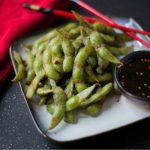Vegetarian Sichuan tofu? You might be wondering, “Isn’t Sichuan cuisine all about meat?” Well, let me tell you, it’s time to rethink that! While Sichuan food is renowned for its bold flavors and fiery spice, it’s also a treasure trove of plant-based delights. And vegetarian Sichuan tofu is one of its shining stars.
Why introduce Sichuan vegetarian tofu?
I remember the first time I tasted vegetarian Sichuan tofu. It was a revelation. The rich, complex flavors, the satisfying texture, and the unexpected heat – it was a culinary adventure I couldn’t resist. I wanted to share this amazing dish with everyone, proving that incredible food doesn’t need meat.
What’s special about Sichuan vegetarian tofu?
Sichuan cuisine is all about balance – sweet, sour, salty, spicy, and umami. Vegetarian Sichuan tofu captures this perfectly. The tofu absorbs the complex flavors of the sauce, becoming a tender, flavorful centerpiece. It’s a dish that’s both comforting and exciting, with a depth of flavor that will keep you coming back for more.
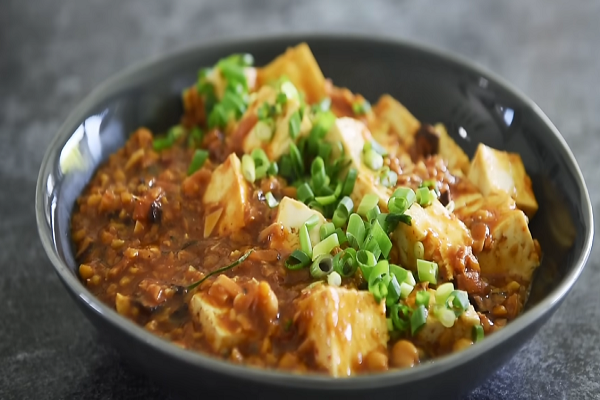
Vegetarian Sichuan Tofu Recipe
Ingredients
- 4 Dry shiitake mushrooms
- 2.5 Cup Water
- 3 Sticks green onion
- 1 Cup Canned chickpeas
- 1 Pound Soft or medium firm tofu
- 2 Pieces garlic
- Small piece ginger
- 1-2 Teaspoon Sichuan peppercorns
- 3 Tablespoon Chili oil
- 3 Teaspoon Chili powder
- 2 Tablespoon Doubanjiang (Chinese spicy broad bean paste)
- Reserved mushroom water
- 1 Teaspoon Cane sugar
- 1 Tablespoon Soy sauce
- Splash of rice vinegar
- 1 Tablespoon Potato starch For slurry
- 1 Tablespoon Water For slurry
Instructions
- Rehydrate Mushrooms: Place four dry shiitake mushrooms into a small saucepan with two and a half cups of water. Cover and bring to a boil. Once boiling, reduce to medium heat and simmer for 10 minutes.
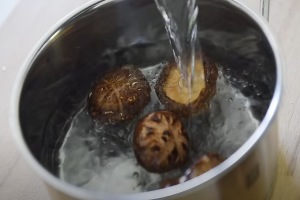
- Prep Ingredients: While mushrooms are rehydrating, chop three sticks of green onion, roughly crush a cup of canned chickpeas with a fork, and slice one pound of soft or medium firm tofu into cubes.
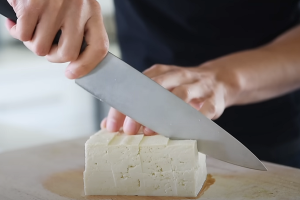
- Cool and Dice Mushrooms: Pour out the mushroom water and set aside. Cool down the mushrooms with cold water, squeeze out the liquid, remove the stalks, and finely dice the mushrooms.
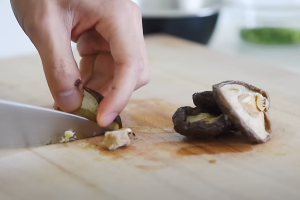
- Prepare Aromatics: Finely chop two pieces of garlic and a small piece of ginger.
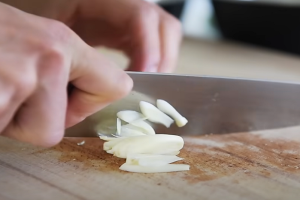
- Toast Peppercorns: Toast one to two teaspoons of Sichuan peppercorns in a saute pan over medium heat for one minute. Grind them down after toasting.
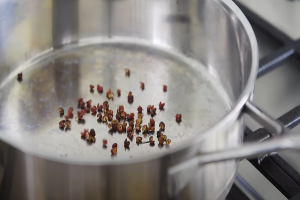
- Cook Ingredients: In a saute pan over medium heat, heat three tablespoons of chili oil. Add the chickpeas and mushrooms, and saute for one to two minutes. Add the garlic and ginger, and saute for another minute.
- Season: Add one teaspoon of chili powder, the crushed Sichuan peppercorns, and two tablespoons of doubanjiang. Pour in the reserved mushroom water, one teaspoon of cane sugar, one tablespoon of soy sauce, and a splash of rice vinegar.
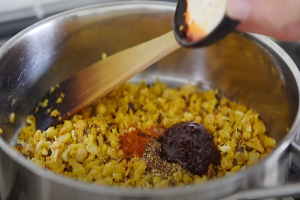
- Thicken Sauce: Make a slurry by combining one tablespoon of potato starch with one tablespoon of water. Pour in the slurry while stirring to thicken the sauce.
- Add Tofu: Gently stir in the tofu cubes to coat them completely with the sauce.
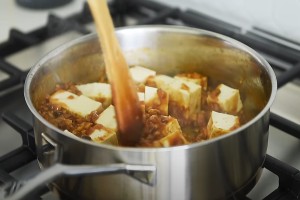
- Serve: Plate the dish and garnish with the chopped green onion.
Video
Notes
- Sichuan Peppercorns: These provide a unique numbing and citrusy flavor. If unavailable, black peppercorns can be used as a substitute, but the flavor will differ.
- Chili Oil: The homemade chili oil adds a smoky and spicy depth to the dish. It’s recommended to make it in advance.
- Tofu Handling: Be gentle when stirring the tofu to prevent it from breaking apart.
- Serve with Rice: This dish pairs excellently with rice, which helps balance the spiciness.
- Prep Ahead: Have all ingredients prepped and ready before you start cooking to ensure a smooth cooking process.
- Mushroom Substitution: If dry shiitake mushrooms are unavailable, fresh shiitake or other mushrooms like cremini or button mushrooms can be used. The texture will be slightly different, but the flavor will still be rich.
- Doubanjiang Selection: Choose a high-quality doubanjiang, as it’s a key ingredient for authentic flavor. Pixian doubanjiang, which is fermented longer, adds a deeper umami and spice to the dish.
- Adjusting Spice Level: If you prefer a milder dish, reduce the amount of chili powder or doubanjiang. Alternatively, you can add more if you like it spicier. The chili oil can also be adjusted to control heat.
- Tofu Texture Variation: For a firmer texture, press the tofu before cooking to remove excess water. This can also help the tofu absorb more of the flavorful sauce.
- Flavor Layering: Toasting the Sichuan peppercorns releases their oils, enhancing the numbing flavor. Be careful not to burn them, as this can lead to bitterness.
- Mushroom Water: The reserved mushroom water contains concentrated umami flavor. You can also use vegetable broth if you prefer a stronger base.
- Garnishing: Besides green onions, you can garnish with toasted sesame seeds or a drizzle of sesame oil for added flavor and texture.
- Health Consideration: If you’re watching your sodium intake, consider using low-sodium soy sauce and reducing the amount of doubanjiang, as it can be quite salty.
- Vegan Adjustments: Ensure that the doubanjiang you use does not contain any animal products, as some versions may include ingredients like shrimp paste.
Tips for cooking vegetarian Sichuan tofu with true Sichuan taste
To achieve authentic Sichuan flavor, use high-quality Sichuan peppercorns. Toast them gently to release their unique aroma. Don’t be afraid to adjust the spice level to your taste. Sichuan cuisine is known for its bold flavors, so have fun experimenting!
How to preserve vegetarian Sichuan tofu
1. Freezing Tofu Separately
- Preparation: Before cooking, you can freeze the tofu separately. Freezing tofu changes its texture, making it chewier and more porous, which allows it to absorb sauces better.
- Process: After freezing, thaw and press the tofu to remove excess water, then cook as usual. This method gives the tofu a different, more meat-like texture.
2. Freezing the Entire Dish
- Portioning: Divide the cooked Mapo Tofu into portions suitable for one meal. This way, you can thaw only what you need.
- Storage: Place the portions in airtight containers or heavy-duty freezer bags. Make sure to remove as much air as possible to prevent freezer burn.
- Freezing Time: The dish can be frozen for up to 1-2 months. Longer storage might affect the texture of the tofu and the overall flavor.
- Reheating: Thaw in the refrigerator overnight and reheat gently on the stove or in the microwave. Add a splash of water or broth to refresh the sauce.
3. Short-Term Storage
- Refrigeration Time: Vegan Mapo Tofu can be stored in an airtight container in the refrigerator for up to 3-4 days. The flavors often deepen after a day, making leftovers even more delicious.
- Reheating: Reheat gently on the stove or in the microwave. Stir occasionally to ensure even heating. You may want to add a bit of water or broth to loosen the sauce as it thickens in the fridge.
FAQ
1. Can I use a different type of tofu?
While extra-firm tofu works best for this recipe, you can experiment with other types. Firm tofu will hold its shape better, while silken tofu will create a creamier texture.
2. What can I substitute for doubanjiang?
If you can’t find doubanjiang, you can use a combination of chili paste and fermented black beans for a similar flavor.
2. Can I make this dish vegan?
Yes, simply use a vegan soy sauce and omit any honey or other animal-based ingredients.
This is just the beginning of your Sichuan culinary adventure. With a little experimentation, you can create countless variations of this delicious dish. Happy cooking!




